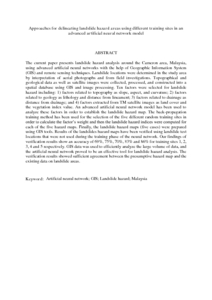Citation
Pradhan, Biswajeet and Youssef, Ahmed Mohamed and Varathrajoo, Renuganth
(2010)
Approaches for delineating landslide hazard areas using different training sites in an advanced artificial neural network model.
Geo-spatial Information Science, 13 (2).
pp. 93-102.
ISSN 1009-5020; ESSN: 1993-5153
Abstract
The current paper presents landslide hazard analysis around the Cameron area, Malaysia, using advanced artificial neural networks with the help of Geographic Information System (GIS) and remote sensing techniques. Landslide locations were determined in the study area by interpretation of aerial photographs and from field investigations. Topographical and geological data as well as satellite images were collected, processed, and constructed into a spatial database using GIS and image processing. Ten factors were selected for landslide hazard including: 1) factors related to topography as slope, aspect, and curvature; 2) factors related to geology as lithology and distance from lineament; 3) factors related to drainage as distance from drainage; and 4) factors extracted from TM satellite images as land cover and the vegetation index value. An advanced artificial neural network model has been used to analyze these factors in order to establish the landslide hazard map. The back-propagation training method has been used for the selection of the five different random training sites in order to calculate the factor’s weight and then the landslide hazard indices were computed for each of the five hazard maps. Finally, the landslide hazard maps (five cases) were prepared using GIS tools. Results of the landslides hazard maps have been verified using landslide test locations that were not used during the training phase of the neural network. Our findings of verification results show an accuracy of 69%, 75%, 70%, 83% and 86% for training sites 1, 2, 3, 4 and 5 respectively. GIS data was used to efficiently analyze the large volume of data, and the artificial neural network proved to be an effective tool for landslide hazard analysis. The verification results showed sufficient agreement between the presumptive hazard map and the existing data on landslide areas.
Download File
![[img]](http://psasir.upm.edu.my/13251/1.hassmallThumbnailVersion/Approaches%20for%20delineating%20landslide%20hazard%20areas%20using%20different%20training%20sites%20in%20an%20advanced%20artificial%20neural%20network%20model.pdf)  Preview |
|
PDF (Abstract)
Approaches for delineating landslide hazard areas using different training sites in an advanced artificial neural network model.pdf
Download (184kB)
| Preview
|
|
Additional Metadata
Actions (login required)
 |
View Item |

